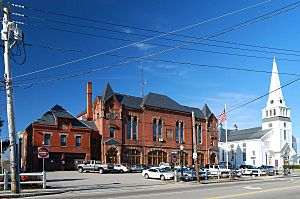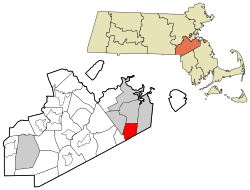Holbrook, Massachusetts facts for kids
Quick facts for kids
Holbrook, Massachusetts
|
||
|---|---|---|

Town Hall
|
||
|
||

Location in Norfolk County in Massachusetts
|
||
| Country | ||
| State | ||
| County | Norfolk | |
| Settled | 1710 | |
| Incorporated | 1872 | |
| Government | ||
| • Type | Representative town meeting | |
| Area | ||
| • Total | 19.2 km2 (7.4 sq mi) | |
| • Land | 19.0 km2 (7.4 sq mi) | |
| • Water | 0.1 km2 (0.1 sq mi) | |
| Elevation | 65 m (212 ft) | |
| Population
(2020)
|
||
| • Total | 11,405 | |
| • Density | 594.0/km2 (1,541/sq mi) | |
| Time zone | UTC−5 (Eastern) | |
| • Summer (DST) | UTC−4 (Eastern) | |
| ZIP Code |
02343
|
|
| Area code(s) | 781 | |
| FIPS code | 25-30455 | |
| GNIS feature ID | 0618322 | |
Holbrook is a town in Norfolk County, Massachusetts, United States. It is located about 17 miles south of Boston. As of 2023, about 12,284 people live there. Holbrook is known for its history and its role as a residential community.
Contents
History of Holbrook
Holbrook was first settled by Europeans in 1710. It was originally the southern part of a larger area called Old Braintree. The town officially became its own town on February 29, 1872. It was the last town created from the original lands of Braintree. Before it became Holbrook, it was known as East Randolph. It was separated from Randolph by the Old Colony Railroad line.
Early Economy and Growth
In the 1700s and 1800s, most people in Holbrook were farmers. They also made things at home, especially shoes. Over time, the town changed. It became a place where many people lived but worked in nearby cities. Many residents traveled to Boston for their jobs. The main jobs within Holbrook itself were in service industries.
Holbrook During the Civil War
Some residents of Holbrook fought in the American Civil War. Soldiers from the famous 54th Massachusetts Volunteer Infantry are buried in Union Cemetery. The war greatly impacted the town. There was a big need for boots for soldiers. Because of this, shoe production became very important to Holbrook's economy. Making shoes moved from homes to factories during this time.
Becoming a Separate Town
The idea of Holbrook splitting from Randolph started in 1871. People in East Randolph wanted their own town. There was a small disagreement about where to put a cupola (a small dome) on top of Stetson Hall. This argument led East Randolph to ask to become a separate town.
The town was named after Elisha N. Holbrook. He was a generous person who gave money for the town hall and library when the town was formed.
Holbrook in the World Wars
Holbrook residents also served in the First and Second World Wars. World War II especially changed the community. After 1945, many soldiers returned home. This led to a building boom across the United States. Holbrook saw many new houses built. It became a community where most people lived and commuted to work in the greater Boston area. Some local jobs are still available in service industries.
Environmental Cleanup Efforts
Holbrook was once home to the Baird and McGuire chemical plant. In 1982, this site was added to a special list by the EPA. This list is for the nation's most polluted sites, called Superfund sites. Holbrook's site was the 14th worst in 1982.
Cleanup work started right away. By June 1997, the main cleanup was finished. Workers burned 248,000 tons of soil, including dirt from the Cochato River. The total cost was about $133 million. A water treatment plant was also built and is still used today.
Geography of Holbrook
Holbrook covers about 7.4 square miles (19.2 square kilometers). Most of this area, about 7.3 square miles (19.0 square kilometers), is land. A small part, about 0.1 square miles (0.1 square kilometers), is water.
Holbrook shares its borders with several other towns:
- To the north: Braintree
- To the east: Weymouth
- To the southeast: Abington
- To the southwest: Brockton
- To the west: Randolph and Avon
Population and People
| Historical population | ||
|---|---|---|
| Year | Pop. | ±% |
| 1880 | 2,130 | — |
| 1890 | 2,474 | +16.2% |
| 1900 | 2,229 | −9.9% |
| 1910 | 2,816 | +26.3% |
| 1920 | 3,161 | +12.3% |
| 1930 | 3,353 | +6.1% |
| 1940 | 3,330 | −0.7% |
| 1950 | 4,004 | +20.2% |
| 1960 | 10,104 | +152.3% |
| 1970 | 11,775 | +16.5% |
| 1980 | 11,140 | −5.4% |
| 1990 | 11,041 | −0.9% |
| 2000 | 10,785 | −2.3% |
| 2010 | 10,791 | +0.1% |
| 2020 | 11,405 | +5.7% |
| 2023* | 11,284 | −1.1% |
| * = population estimate. Source: United States Census records and Population Estimates Program data. | ||
In 2020, Holbrook had a total population of 11,405 people. This means there were about 1,563.6 people living in each square mile. There were 4,879 homes in the town. On average, about 2.4 people lived in each home. About 57.3% of homes had married couples.
Diversity in Holbrook
The people in Holbrook come from many different backgrounds.
- About 75% of residents are White.
- About 11.5% are Black or African American.
- About 1.30% are Asian and Pacific Islander.
- About 1.11% are from other races.
- About 10.6% are from two or more races.
- About 7.2% of the population is Hispanic or Latino.
- About 12.6% of the people living in Holbrook were born outside the United States.
Age Groups in Holbrook
The population in 2020 included:
- 19.3% of people under 18 years old (with 4.9% under age 5).
- 17.5% of people over 65 years old.
- The remaining 63.2% of residents were between 18 and 64 years old. This is similar to other areas nearby.
| Age | Percent |
|---|---|
| 0-9 | 9.7% |
| 10-19 | 12.8% |
| 20-29 | 6.8% |
| 30-39 | 14.3% |
| 40-49 | 16.3% |
| 50-59 | 14.9% |
| 60-69 | 13.5% |
| 70-79 | 8.2% |
| 80+ | 3.6% |
Money and Education
The average income for a household in Holbrook was $89,763. The average income per person was $41,324. About 7% of the population lived below the poverty line. This includes 12.6% of people aged 65 or older and 0.9% of children under 18.
Most people in Holbrook have a good education.
- About 93.2% of residents have graduated from high school.
- About 30.6% have gone on to higher education.
- 23.4% have a Bachelor's degree.
- 7.2% have a post-graduate degree (like a Master's or PhD).
- Only 6.9% of people in Holbrook do not have any degree. This is lower than the state average.
Education in Holbrook
Holbrook has two main schools. They are both located in the same building complex. These new schools opened in 2017.
The schools are:
- John F. Kennedy Elementary School (for students from Pre-Kindergarten to 5th grade)
- Holbrook Middle-High School (for students from 6th to 12th grade)
These new schools replaced the town's older schools. The new complex is built on the same land where the old Holbrook Junior-Senior High School used to be.
Transportation and Travel
Holbrook has important roads that help people get around. The main highways are Route 37 and Route 139. These two roads meet in the center of town.
Public Transportation
You can take a train from Holbrook to South Station in Boston. This is called commuter rail service and runs on the Middleboro line from the Holbrook/Randolph Rail Station.
Holbrook is also part of the Massachusetts Bay Transportation Authority (MBTA). This group provides bus services.
- The 230 Bus goes from Holbrook to Quincy Center Station.
- The MBTA also offers a special service called THE RIDE. This is for elderly and disabled people who need help with transportation.
- The 238 and 240 buses operate from the Holbrook-Randolph Station. These buses can take you to Quincy Center MBTA Station, Avon, and Ashmont MBTA station.
Notable People from Holbrook
Many interesting people have come from Holbrook:
- Elihu Adams - He was the brother of President John Adams. He was also a Minuteman, a soldier in the Continental Army during the American Revolution.
- Andrew Card - He was the White House Chief of Staff for President George W. Bush. This means he was a very important helper to the President from 2001 to 2006.
- George Mason Lovering - He received the Medal of Honor, which is the highest military award in the United States.
- Jim Mann - A professional baseball pitcher who played for several seasons.
- Joe Pernice - An indie rock singer and songwriter. He leads the bands Pernice Brothers and Scud Mountain Boys.
- Michael Sullivan - He was a United States Attorney for the District of Massachusetts. This means he was a top lawyer for the government in that area.
See also
 In Spanish: Holbrook (Massachusetts) para niños
In Spanish: Holbrook (Massachusetts) para niños


